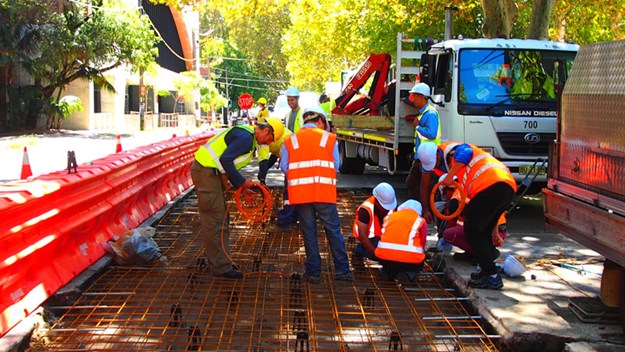Concrete made using industrial waste from coal-fired power stations and steel manufacturing is being used in a world-first green roads trial in Sydney
 |
|
Nine sensors places underneath the road surface will monitor how well the Geopolymer concrete performs
|
The City of Sydney is putting the environmentally friendly building product to the test on a busy inner-city street, replacing a 30 metre section of roadway on Wyndham Street in Alexandria.
To test the green concretes durability, the City has laid 15m of traditional concrete and 15m of Geopolymer concrete; a sustainable blend of concrete and recycled materials.
Nine sensors have been positioned under the concrete to monitor and compare how the Geopolymer concrete performs.
UNSW Sydney researchers and the CRC for Low Carbon Living (CRCLCL) will then use results from the trial to create the first set of industry guidelines for Geopolymer concrete.
Made from fly ash and blast furnace slag, Geopolymer generates just 300kg of carbon dioxide per tonne of cement, compared to the 900kg from traditional cement production – saving the equivalent of the electricity used by an average household every two weeks.
UNSW Sydney researchers will monitor the road performance for up to five years. Professor Stephen Foster, head of the School of Civil and Environmental Engineering, is the CRCLCL project lead and describes the trial as “a huge step forward”.
“This trial will help drive step change in the industry. Many concrete companies are already doing a lot to change, but this trial really gives it another push,” Foster says.
“While we’ll monitor the road performance for up to five years, a lot of the data collected in the first three to 12 months of this world-first trial will be used to confirm our models and strengthen our predictions.
“Concrete contributes seven per cent of all greenhouse gas emissions and in 2018 the world produced about 4.1 billion tonnes of cement, which contributed about 3.5 billion tonnes of CO2.
“Alternative, low CO2 concrete materials offer potential benefits in reducing the greenhouse gas emissions associated with conventional concrete.
“This trial is important because we need demonstration projects to accurately assess the performance of Geopolymer over time so that there can be broader uptake.”

